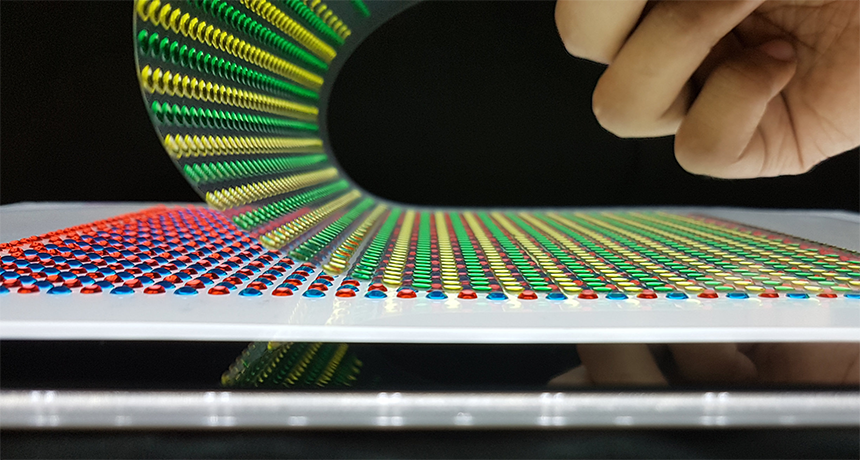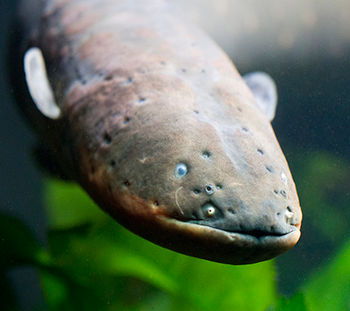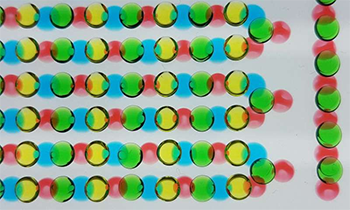This power source is shockingly eel-like
A new kind of squishy-power generator mimics an electric eel’s zap

When pressed together, sheets of gels can produce electricity. This flexible power source was inspired by electric eels.
Thomas Schroeder and Anirvan Guha
Electric eels are legendary for their ability to stun prey with a high-voltage jolt. Inspired by the creature, scientists have adapted the eel’s stunning secret to build a squishy, flexible new way to make electricity. Their new artificial electric “organ” could supply power in situations where regular batteries simply wouldn’t work.
With water as its main ingredient, the new artificial organ can work where it’s wet. So such a device might power soft-bodied robots that have been designed to swim or move like real animals. It might even be useful inside the body, such as to run a heart pacemaker. And it generates power through a simple motion: just a squeeze.

A research team based in Switzerland described the new device February 19 at a scientific meeting in San Francisco, Calif.
Electric eels generate their electric charge using specialized cells. Known as electrocytes, those cells take up most of an eel’s 2-meter- (6.6-foot-) long body. Thousands of these cells line up. Together, they look like rows upon rows of stacked hot-dog buns. They are a lot like muscles — but don’t help the animal swim. They direct the movement of charged particles, called ions, to generate electricity.
Tiny tubes connect the cells, like pipes. Most of the time, these channels let positively charged molecules — ions — flow outward from both the front and back of a cell. But when the eel wants to impart an electric shock, its body opens some of the channels and closes others. Like an electric switch, this now lets positively charged ions flow in one side of the channels and out the other.
As they move, these ions build a positive electric charge in some places. This creates a negative charge in other places. That difference in charges sparks a trickle of electricity in each electrocyte. With so many electrocytes, those trickles add up. Together, they can produce a jolt strong enough to stun fish — or fell a horse.
Dot to dot
The new artificial organ uses its own version of electrocytes. It looks nothing like an eel, or a battery. Instead, colored dots cover two sheets of transparent plastic. The whole system resembles a couple of sheets of colorful, fluid-filled bubble wrap.
The color of each dot denotes a different gel. One sheet hosts red and blue dots. Salt water is the main ingredient in the red dots. The blue dots are made from freshwater. A second sheet has green and yellow dots. The green gel contains positively charged particles. The yellow gel has negatively charged ions.
To make electricity, line up one sheet above the other and press.

The red and blue dots on one sheet will nestle between green and yellow ones on the other sheet. Those red and blue dots act like the channels in the electrocytes. They will let charged particles flow between the green and yellow dots.
Just as in an eel, this movement of charge makes a tiny trickle of electricity. And also as in an eel, a lot of dots together can impart a real jolt.
In lab tests, the scientists were able to generate 100 volts. That’s almost as much as a standard U.S. electric wall outlet delivers. The team reported its initial results in Nature last December.
The artificial organ is easy to make. Its charged gels can be printed using a 3-D printer. And as the main ingredient is water, this system is not costly. It’s also fairly rugged. Even after being pressed, squished and stretched, the gels still work. “We don’t have to worry about them breaking,” says Thomas Schroeder. He led the study with Anirvan Guha. Both are graduate students in Switzerland at the University of Fribourg. They study biophysics, or how the laws of physics work in living things. Their team is collaborating with a group at the University of Michigan in Ann Arbor.
Hardly a new idea
For hundreds of years, scientists have tried to imitate how electric eels work. In 1800, an Italian physicist named Alessandro Volta invented one of the first batteries. He called it the “electric pile.” And he designed it based on the electric eel.
“There is much folklore about using electric eels to generate ‘free’ electricity,” says David LaVan. He’s a materials scientist at the National Institute of Standards and Technology in Gaithersburg, Md.
LaVan did not work on the new study. But 10 years ago, he led a research project to measure how much electricity an eel produces. Turns out, an eel isn’t very efficient. He and his team found that the eel needs a lot of energy — in the form of food — to create a small jolt. So eel-based cells “are unlikely to replace other renewable energy sources,” such as solar or wind power, he concludes.
But that doesn’t mean they couldn’t be useful. They are appealing, he says, “for applications where you want a small amount of power without metal waste.”
Soft robots, for example, may be able to run on a small amount of power. These devices are being designed to go into harsh environments. They might explore the ocean floor or volcanoes. They might search disaster zones for survivors. In situations such as these, it’s important that the power source won’t die if it gets wet or squished. Schroeder also notes that their squishy gel grid approach might be able to generate electricity from other surprising sources, such as contact lenses.
Schroeder says it took the team a lot of trial and error to get the recipe right for its artificial organ. They worked on the project for three or four years. Over that time, they created many different versions. At first, he says, they didn’t use gels. They tried using other synthetic materials that resembled the membranes, or surfaces, of electrocytes. But those materials were fragile. They often fell apart during testing.
Gels are simple and durable, his team found. But they produce only small currents — ones too tiny to be useful. The researchers solved this problem by creating a large grid of gel dots. Dividing those dots between two sheets let the gels mimic the eel’s channels and ions.
The researchers are now studying ways to make the organ work even better.
This is one in a series presenting news on technology and innovation, made possible with generous support from the Lemelson Foundation.







